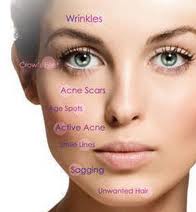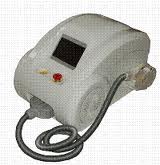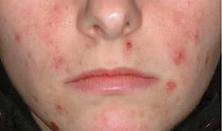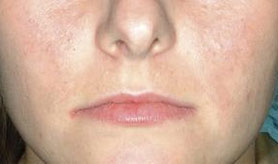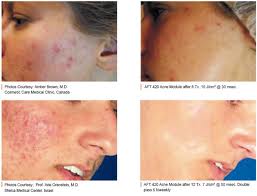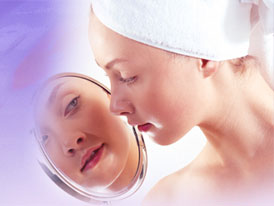


|
||||||||||||||||||||||||||||||||||||||||||||||
|
|
|
|
PRICE LIST Acne Treatment
FDA APPROVED TGA APPROVED CE CERTIFIED
How does the removal system work? The IPL (Intense Pulsed Light Therapy) removal procedure produces a high intensity flash of filtered light from the applicator head, which has been placed in contact with the skin. The energy from the light source is absorbed by the pigment melanin, which is the chromospheres. The glass applicator is placed in contact with skin surface and the light is pulsed through it onto the skin. The applicator is then moved to the neighbouring area and the process is repeated. IPL FOR ACNE TREATMENT IPL (Intense Pulsed Light) treatment has been described as the most significant advancement in acne treatment for decades. It is a safe, fast, effective, and FDA approved procedure designed to control existing acne outbreaks and reduce future acne outbreaks.
An IPL system generates high energy pulses of light that are filtered to emit specific frequencies of light. One of these frequencies causes porphyrin, a naturally occurring molecule in the oil glands, to release oxygen. The acne bacteria are anaerobic and are killed by the oxygen. A second frequency disables the overactive oil glands, causing them to shrink. This controls the overproduction of sebum (oil) to help prevent later outbreaks.
During the treatment, you will be asked to put on protective eyewear. A cooling machine is utilized and the cooling head is applied over the treatment area to cool the skin and allow the light to more easily penetrate the skin's surface. The IPL hand piece is placed against the skin and a short pulse of light is released. The hand piece is moved to the neighbouring area and the process is repeated until the entire area has been treated. Most clients describe the sensation of the pulses as a small, relatively painless snap, much like that of a rubber band. For treatments that significantly heat the lower layers of skin, the cooling machines hand piece may be used to reduce both redness and the build up of heat at the target area. Once the treatment is complete and the client no longer feels any heat acne fighting products are applied to complete the treatment.
Who are the best candidates for IPL Acne Treatments? This treatment works best for people with light coloured skin because the pigment in our skin (melanin) also absorbs the light energy. Darker skin can be treated but the light energy must be delivered at a lower power to prevent burning of the skin. As a result, darker skin will likely require more treatments. This includes skin with tans resulting from exposure to the sun, tanning beds, or the application of tanning lotions.
IPL treatments Should NOT be performed if you have taken Accutane within the past twelve months.
What results can you expect? Clinical studies have shown IPL treatments to be comparable to prescription antibiotics for the treatment of acne. Results are normally seen within two weeks with continued improvement over the following three months.
IPL treatments also stimulate collagen production to help repair the damage caused by the acne infection. As a result the treatment provides long lasting improvement in both acne and the overall skin texture.
How many treatments do you need? We recommend two treatments per week for four weeks (a total of eight treatments). Single treatments are available for maintenance and topical products for home use may be suggested by your therapist.
Things you should know. Side effects are rare and limited to the treatment sites. Acne is unpredictable and one of the toughest skin conditions to treat. Because there are so many variables related to acne (bacteria levels, hormone fluctuations, whether your skin is dry or oily, stress, medications, etc), there are no guarantees that this or any other acne treatment can completely or permanently stop the production of blemishes. However, these treatments, combined with following the regular facial treatment and home care recommendations of your therapist, should provide a significant reduction in blemishes, inflammatory pigmentations, and oil production.
How much time is required? Each appointment is normally 30 minutes.
What can IPL be used for? Skin Rejuvenation – signs of aging with collagen damage Pigmented spots, freckles and sun damaged skin Acne scarring & other scars Rosacea & Capillaries Unsightly small veins and capillaries on face and body Hair Removal Face & Body
PRICE LIST Acne Treatment
Chin $90 Jaw Line $120 Nose/ Ears $50 BODY Lower Back $180 Neck $100
Chest $320 PACKAGES 6 FOR THE PRICE OF 5 IPL CONTRAINDICATIONS AND PHOTOSENSITIZING MEDICATIONS We cannot treat anyone who has known or reported the following unless a letter fromyour GP is available confirming that the medical condition(s) will not prevent treatmentusing intense pulsed light: • Tanned skin (active tan) through sun exposure or tanning bed use in the previous30 days (because of increased risk of hyper pigmentation). However, we are able to IPL dark skin types. If you would like to have an IPL treatment, you get quicker results the lighter the skin, so avoid tanning or even spray tanning on that area. • IPL Hair Removal -Waxing, plucking, ‘sugaring’ or ‘threading’ depilation treatment of the area in the previous 4 – 6 weeks (because the follicle has been removed). • Hypo pigmentation (e.g. Vitiligo). • Any inflammatory skin condition e.g. eczema, active Herpes Simplex, etc. at thetreatment site (because it may aggravate the condition). • Skin cancer or any other cancer and / or who reports he/she is undertaking anycancer drug therapy (such as Ducabaxine, Fluorouracil, Methotrexate, etc). • A history of Keloid scarring (because any IPL burn may produce a Keloid scar). • Epilepsy (because repeated consecutive flashes may induce a fit). • Using St John’s Wort (herbal remedy) in the past 3 months for depression (owingto photosensitivity). • Who has oral Isotretinoin-Roaccutane or Tretinoin-Retin A in the previous 3 – 6 months for the treatment of acne or other dermatological conditions. • Who is pregnant; until periods return and end of breast feeding (becausehormonal imbalance may reduce treatment effectiveness). • Who takes drugs for diabetes (owing to possible photosensitivity and poor wound healing). • Taking anti-coagulant drugs (e.g. for heart disease). • Wearing a pacemaker unless the IPL or pacemaker manufacturer confirms in writing that it is safe to treat the client wearing the pacemaker. • Taking any topical medication (e.g. hydrocortisone) or wearing perfumes, deodorants, sun block, essential oils or other skin lotions (which could cause photosensitivity). So, make sure that you wash them off before hand. • Surgical metal pins or plates under the tissue to be treated. • To be less than 18 years of age as our establishment is not registered to treat children with IPL. A doctor’s letter will be required before treating clients who are reportedly using Quinidine, any anti-psychotic medication or large combinations of cardiac / diuretic drugs, topical steroid creams in the area to be treated, general anaesthesia in the IPL contraindications and photosensitizing medications vers 1.0 February 2009 last 3 months, local anaesthetic near treated areas in the past month or where you are uncertain about any reported medical condition or medication. A doctor’s letter will be required for those clients who have reported a fake tan, suffering with allergies, has hormone abnormalities such as polycystic ovarian syndrome, has cold sores in the treatment area, has reported HIV or Hepatitis. Transsexuals may be treated although results can vary and IPL treatment should follow 6 months after completion of hormone therapy. Conditions that affect hormone levels such as thyroid conditions, oral steroids, hormonal therapy and polycystic ovaries can be treated but results may vary and realistic outcomes may be reduced or delayed. Information on Drug-Induced Photosensitivity There are many drugs and some herbal remedies available at the moment that can cause the skin to become very sensitive to light. Whether these drugs are taken by mouth or applied to the skin, a reaction can occur. This reaction is called ‘Drug-Induced Photosensitivity’. Therefore, it is very important that you read this information and notify the Operator of any drugs that you may be using. Photosensitivity reactions can be divided into two groups: Photo-Toxic Reactions - these are dose related and can be seen to a slight degree in people who are exposed to sunlight (presumed to be due to the UV component). Photo-Allergic Reactions – these involve the immune system and may be similar to other allergic reactions, swelling, rashes and hives. The drugs cause this reaction by absorbing either UV or visible radiation from sunlight or the Equipment light (which is in the visible part of the spectrum) that is delivered by IPL systems. Types of Photosensitivity: · Abnormal and extreme sunburn · Stinging and burning · Vesicles- A small sac or cyst containing fluid or gas · Hives · Swelling The degree of photo-sensitive response is also normally dose-related, so the higher the dose of a particular photosensitive drug (or herbal remedy such as St. John’s Wort), the greater the probability of a reaction and the greater the degree of skin response. There is a web site that can be used for further information visit http://emc.medicines.org.uk/ and insert the medication name. If still in doubt contact us on (01865) 730044 and we can refer to in-house medication charts. |
|
|
|
||
| Site Map |
